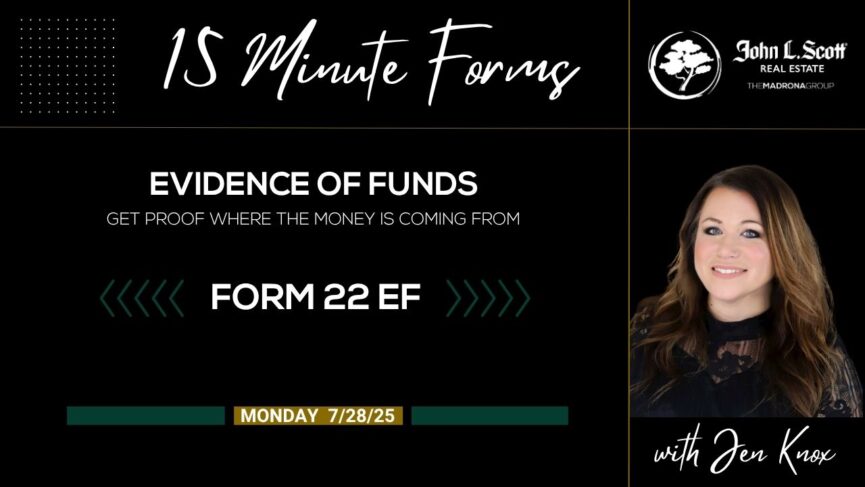“Evidence of Funds isn’t a contingency—it’s a disclosure that tells sellers where 100% of your funds are coming from.”
That insight has become increasingly important in today’s Seattle real estate market, where trust, transparency, and smart paperwork make all the difference.
If you’ve been wondering “What is Form 22EF Evidence of Funds?”, you’re not alone. Buyers and sellers in Seattle, Snohomish County, and King County often want to know how to clearly present a buyer’s financial position when making or accepting an offer. This blog post is your go-to breakdown on what this form does, when to use it, and how it plays into crafting a strong real estate offer.
What to Expect:
- Why Form 22EF Evidence of Funds Addendum is important in Washington real estate
- What qualifies as non‑contingent vs. contingent funds
- When not to use the form—especially if you’re using Forms 22A, 22B, or 22Q
- What timelines matter and how they affect both buyer and seller
- Advice from The Madrona Group’s Jen Knox in her latest 15-Minute Forms video
- FAQ and takeaways for boosting your knowledge and search visibility
What Is the Evidence of Funds Addendum (Form 22EF)?
Form 22EF is a one-page form that helps buyers disclose where their money is coming from to complete the purchase of a home. It doesn’t add any contingencies—it’s simply a way to provide full transparency to the seller. The form helps account for 100% of the buyer’s funds and outlines whether those funds are already available or if something needs to happen before they are.
Funds fall into two categories:
- Non‑contingent funds: These are already in the buyer’s bank account, available to be used right away.
- Contingent funds: These require an action before the money becomes usable, like selling stocks, receiving a gift, or liquidating a retirement account.
When and Why You Should Use Form 22EF
Buyers typically include Form 22EF when they haven’t already provided a bank statement or other proof of funds with their offer. It gives sellers peace of mind that the money to buy the home is real—and on the way.
If your buyer is using non‑contingent funds, you check the appropriate box on the form and provide documentation within the default three days after mutual acceptance. This could be a screenshot or statement from a checking or savings account.
When the money isn’t quite ready yet—say it’s coming from grandma as a gift or tied up in stocks—you mark it as contingent and outline the expected action and timeline. These funds need to be converted to cash in time for closing, and the seller is informed but not bound to wait if deadlines are missed.
However, if your offer already includes financing disclosures through other forms like 22A (Financing Contingency), 22B (Buyer’s Sale of Property), or 22Q (Pending Sale of Buyer’s Property), do not list those funds again on Form 22EF. Doing so can weaken your buyer’s protection under those contingency forms.
Non‑Contingent vs Contingent Funds: What’s the Difference?
Non‑Contingent Funds mean your buyer is financially ready now. They have liquid cash in a U.S. bank account, and you can provide documentation to prove it. These are the strongest funds in a seller’s eyes because they come with no extra steps or uncertainties.
Contingent Funds come with a “but.” Your buyer might have to wait for a stock sale to clear, a 401(k) withdrawal to process, or a family member to send a gift. These are still usable—but they carry a risk if the timeline doesn’t go as planned.
The key thing to remember: Form 22EF is not a contingency. If funds fall through, the buyer can’t rely on this form as a get-out-of-jail-free card. If proof isn’t provided by the stated date, the seller can terminate the agreement. The buyer may lose their earnest money and still be obligated to close unless another form in the offer gives them that protection.
How Jen Knox Recommends Filling Out Form 22EF
In her latest 15-Minute Forms video, Jen Knox of The Madrona Group emphasized the importance of using this form only when necessary—and using it correctly.
You’ll fill out the transaction information in the top lines, select the correct fund type (non-contingent or contingent), and describe any actions needed for contingent funds. You’ll also specify timelines: non‑contingent funds default to proof within three days of mutual acceptance, while contingent fund deadlines count backward from closing.
Jen also warned: don’t double-dip your disclosures. If you’re using Form 22A for financing or Form 22Q for a pending home sale, don’t repeat those same funds on Form 22EF. It can void the protection those other forms provide, which could leave your buyer exposed.
FAQs: Answering Your Top Questions
Q: Do I need to include Form 22EF in every transaction?
Not necessarily. If your buyer has already provided a bank statement or pre-approval with fund evidence, or if you’re fully covered with other forms, it may not be needed.
Q: Can I use Form 22EF to protect my buyer if their funds fall through?
No. This form is only a disclosure. It doesn’t act as a contingency or safeguard.
Q: What if I include both 22A and 22EF listing the same funds?
Don’t. This creates confusion and could remove your buyer’s protection under 22A. Only disclose those funds in one place.
Q: What’s an example of contingent funds?
A buyer planning to sell stocks or receive a gift from a relative would mark those as contingent because some action still needs to take place.
Key Takeaways
- Form 22EF gives sellers a clear picture of where the buyer’s money is coming from.
- Use non‑contingent funds for cash already in the bank, and provide proof within three days.
- Use contingent funds if money needs to be transferred, liquidated, or otherwise prepared.
- Don’t duplicate disclosures across 22A, 22B, or 22Q—each form serves its own purpose.
- Missing proof deadlines doesn’t give the buyer a way out—it gives the seller an option to terminate.
Internal Resources to Check Out
- Want to understand more about financing? Start with Understanding financing addendum
- Need help getting buyer-ready? Read Why you should be buyer-ready day one
- Curious about financing options? Don’t miss the Quick mortgage guide real estate buyers
- Selling soon and expecting a cash offer? Brush up with Getting a cash offer when selling
- Understanding buyer protections? Learn more at Buyer agency law
Final Thoughts on Evidence of Funds
If you’re writing or reviewing a purchase agreement in the Seattle area, Form 22EF is your friend—but only if used wisely. It’s not a contingency, but it is a powerful way to keep your offer clean, transparent, and easy for the seller to evaluate. Knowing how to categorize funds, hit the right timelines, and avoid duplicate disclosures could be the key to a smooth transaction.
And with the changes in buyer broker agreements and compensation disclosures, having a Seattle real estate broker like the team at The Madrona Group in your corner ensures your paperwork aligns with new rules and avoids costly oversights.
Have questions about writing a strong offer in King or Snohomish County? Let’s connect and make sure every piece of your deal is airtight.
Share this post!




